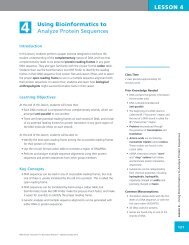WET LAB DNA Barcoding: From Samples to Sequences - Northwest ...
WET LAB DNA Barcoding: From Samples to Sequences - Northwest ...
WET LAB DNA Barcoding: From Samples to Sequences - Northwest ...
Create successful ePaper yourself
Turn your PDF publications into a flip-book with our unique Google optimized e-Paper software.
<strong>WET</strong> <strong>LAB</strong><br />
CLASS SET<br />
Procedure:<br />
[Note: Work in groups of up <strong>to</strong> 4 students.]<br />
1. Obtain ice in your ice container. PCR primers should be kept cold.<br />
2. PCR tubes are very small and do not permit complicated labels. On a separate sheet of paper or in your lab<br />
notebook, make a table like the one below (Table 2.1) <strong>to</strong> list each <strong>DNA</strong> sample purified in Part 1 by you and<br />
your group members, and the number that you will use <strong>to</strong> label your PCR tubes. Your PCR tube should<br />
also include your initials, such as “JT” in the examples below.<br />
Table 2.1: <strong>DNA</strong> <strong>Samples</strong> and PCR Test Tube Labels:<br />
PCR Tube Label<br />
Species (or sample number) from which <strong>DNA</strong> was purified<br />
*1 ____________________________________________________<br />
*2 ____________________________________________________<br />
*3 ____________________________________________________<br />
*4 ____________________________________________________<br />
* Be sure <strong>to</strong> include your initials in addition <strong>to</strong> the tube number.<br />
Example:<br />
JT1<br />
Joe Ting’s Salmon <strong>DNA</strong> from Puget Sound, Washing<strong>to</strong>n<br />
3. The PCR tubes are the small, 0.2 ml clear tubes provided by your teacher (See Figure 2.1). Each tube contains<br />
a small white bead that includes the Taq <strong>DNA</strong> polymerase, deoxyribonucleotides (dNTPs), and buffer. Obtain up<br />
<strong>to</strong> five tubes for your group: one for each student, and one for the negative control.<br />
4. Label each PCR tube as you described in Table 2.1 (for example, “JT1” or “JT2”).<br />
Using Bioinformatics: Genetic Research<br />
5. Label one PCR tube with one of your group member’s initials and a “0” (for your group’s Negative Control, for<br />
example, “JT0”).<br />
6. Obtain a 1.7 ml microfuge tube for each member of your group and label this tube as you described in Table 2.1<br />
(for example, “JT1” or “JT2”).<br />
7. Obtain a 1.7 ml microfuge tube for your group and label it with the initials and “0” for your Negative Control<br />
(as in Step #5 above).<br />
8. Briefly “spin down” each tube of PCR primers using a microcentrifuge. This will force all of the liquid in<strong>to</strong> the<br />
bot<strong>to</strong>m of the tubes <strong>to</strong> ensure accurate measurement with your micropipette.<br />
356<br />
©<strong>Northwest</strong> Association for Biomedical Research—Updated Oc<strong>to</strong>ber 2012
















